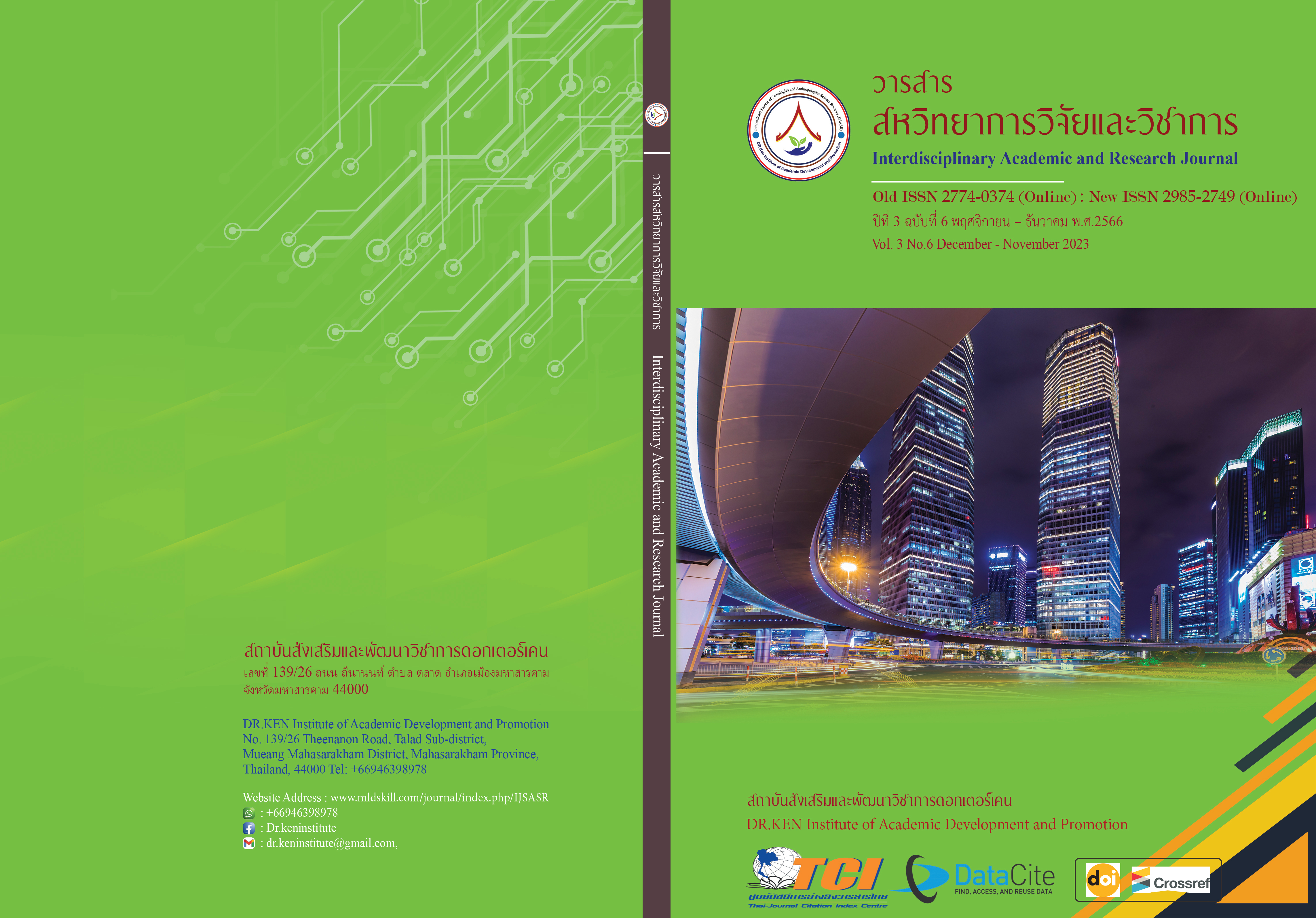Factors Affecting Sericulture Groups Decision Making on Career Sustaining in The Queen Sirikit Regional Office of Sericulture3, Khon Kaen Province
DOI:
https://doi.org/10.60027/iarj.2023.271976Keywords:
Mulberry Cultivating Farmers; , Career Decision-Making; , Factors Affecting Career PursuitAbstract
Background and Aims: The occupation of agriculture has been closely associated with the Thai people for a long time. The cultivation of mulberry and sericulture have become alternative professions for Thai farmers. However, the number of individuals engaged in this profession is decreasing daily. This is due to the impact of borderless communication, the emergence of a new era of trade, and environmental changes, all of which affect farmers' livelihoods. The objective of this research was to study 1) The situation of mulberry cultivation and sericulture in the responsibility area of the Mulberry Cultivation Promotion Office, Region 3, which includes Khon Kaen Province. 2) The adaptation of farmers to economic, social, political, and technological changes. 3)Factors influencing the career decisions of the group of farmers.
Methodology: The research methodology used is a mixed-method approach, with a sample group consisting of members engaged in mulberry and sericulture cultivation in six provinces: Chaiyaphum, Kalasin, Roi Et, Maha Sarakham, Mukdahan, and Khon Kaen, totaling 361 individuals. The research tools used include questionnaires and group interviews. Statistical analysis methods used include averages, percentages, and multiple regression analysis.
Results: The study found that most mulberry and sericulture farmers primarily rely on household labor and typically own less than five rai of land. Many face challenges related to water availability for mulberry cultivation, with some areas experiencing insufficient water for adequate mulberry growth. There is a willingness among these farmers to adopt technological advancements in production and product processing with the assistance of government knowledge transfer initiatives. They also work to reduce unnecessary costs and collaborate in market negotiations. Factors influencing career decisions include personality traits, knowledge, understanding, and perception of the profession, job stability in mulberry and sericulture cultivation, quality of life, production/system management, land area used for cultivation, increasing age of farmers, succession planning, and participation in farmer groups.
Conclusion: Most mulberry and sericulture farmers are the main household laborers, have an area of no more than 5 rai/household, have problems with water and dryness, and try to adapt to technology and receive assistance from the government. Factors affecting the decision to maintain a career include personality traits, knowledge, job stability, quality of life, production system, growing area, age, occupational succession, and joining groups for market bargaining.
References
จิระศักดิ์ เพชรมีศรี. (2557). การอบรมหลักสูตรเทคโนโลยีการจัดการสวนหม่อนให้ถูกหลักวิชาการและเพิ่มผลผลิต โครงการปรับโครงสร้างการผลิตหม่อนไหมอุตสาหกรรม วันที่ 3 - 5 มีนาคม 2557 ณ วัดห้วยเฮี้ย ต.ห้วยเฮี้ย อ.นครไทย จ.พิษณุโลก. ศูนย์สารสนเทศหม่อนไหมและประชาสัมพันธ์ กรมหม่อนไหม.
ณรงค์ฤทธิ์ วิจิตรจันทร์. (2554) การปลูกหม่อนเลี้ยงไหม : แง่คิดพิจารณาก่อนตัดสินใจเลี้ยงไหม. กรุงเทพฯ: สถาบันวิจัยหม่อนไหม กรมวิชาการเกษตร.
นิชานันท์ คงทวีและ ประภัสสร เกียรติสุรนนท์. (2559). ปัจจัยที่มีผลต่อการตัดสินใจเลี้ยงไหมของเกษตรกร ในจังหวัดขอนแก่น. วารสารแก่นเกษตร, 44 (4), 631-638.
พงศ์ หรดาล. (2540). จิตวิทยาอุตสาหกรรมและองค์การเบื้องต้น.กรุงเทพฯ: มหาวิทยาลัยศรีปทุม.
ภาณุพันธุ์ ประภาติกุล และ ประสิทธิ์ เพ็ชรสุข. (2557). แนวทางการพัฒนาความรู้ด้านการผลิตหม่อนไหมของเกษตรกรในจังหวัดนราธิวาส. แก่นเกษตร, 42 (2), 211-220.
ลำแพน สารจันทึก อำนาจ ตนัยพุฒิ พิมลรัตน์ เมธินธรังสรรค์ กนกวรรณ วรวงศ์สมคำ เบ็ญจมาศ แก้วรัตน์ พิญญ์พัชร์ ตรีฉิมพลี อาภาพร ขันตี. (2560). การศึกษารูปแบบการถ่ายทอดองค์ความรู้ในการส่งเสริมอาชีพการปลูกหม่อน เลี้ยงไหมในเขตพื้นที่กลุ่มจังหวัดนครชัยบุรินทร์ และกลุ่มจังหวัดร้อยแก่นสารสินธุ์. รายงานวิจัยศูนย์หม่อนไหมเฉลิมพระเกียรติ สำนักวิจัยและพัฒนาหม่อนไหม กรมหม่อนไหม : กรุงเทพฯ.
วิโรจน์ แก้วเรือง. (2560). สาระน่ารู้หม่อนไหม การเลี้ยงไหมต้องปรับเมื่อโลกเปลี่ยน. Retrieved 17 May 2017 from: https://www.gotoknow.org/posts/500544.
ศิริพร บุญชู และสิทธิ ภูมิวัฒนะ. (2557). การวิเคราะห์เศรษฐกิจการส่งออกผ้าทอไหมและผลิตภัณฑ์ไหมไทย. สำนักอนุรักษ์และตรวจสอบมาตรฐานหม่อนไหม สำนักพัฒนาและถ่ายทอดเทคโนโลยีหม่อนไหม. กรุงเทพฯ: กรมหม่อนไหม.
ศุภกฤต จันทรวิชญ์ พิชัย เชื้องาม เยาวลักษณ์ ทองทวี และชุมญาณัช คำวงษ์. (2560). ความต้องการได้รับการส่งเสริมของผู้ปลูกหม่อนเลี้ยงไหมพันธุ์ไทยพื้นบ้านในเขต จังหวัดอุบลราชธานี ประจำปี 2559. รายงานฉบับสมบูรณ์. สำนักงานหม่อนไหมเฉลิมพระเกียรติฯ เขต 6 จังหวัดศรีสะเกษ ศูนย์หม่อนไหมเฉลิมพระเกียรติฯ อุบลราชธานี สำนักพัฒนาและถ่ายทอดเทคโนโลยีหม่อนไหม.
ศุภชัย ยาวะประภาษ. (2544). การวิจัยทางรัฐประศาสนศาสตร์. กรุงเทพฯ: โครงการผลิตตำราและเอกสารการสอน
ศุภวรรณ เคี่ยนเมธี, สมหญิง ชูประยูร, ชาติ ศรีแสง, มยุรี ชมพูพื้น, พิมลรัตน์ เมธินธ์รังสรรค์, ภาวิณี อาสน์สุวรรณ และอาภาพร ขันตี (2561). การศึกษาการยอมรับเทคโนโลยีการผลิตหม่อนไหม เพื่อนำไปปฏิบัติตาม ในการเพิ่มประสิทธิภาพการผลิตในระดับเกษตรกร. กรุงเทพฯ: กรมหม่อนไหม.
สำนักงานสถิติแห่งชาติ (2561) การสำรวจภาวะการทำงานของประชากร สำนักงานสถิติแห่งชาติ กระทรวงเทคโนโลยีสารสนเทศและการสื่อสาร. กรุงเทพฯ: สำนักงานสถิติแห่งชาติ. ISSN 0858-0200.
Beach, D.S. (1965). Personnel: Management of People at Work. New York: The Macmillan. Co. Ltd.
Ginzberg, E. (1974). Career Guidance. New York: McGraw-Hill Co.
Hoppock, R. (1976). Occupational Information. 4th ed. New York: McGraw-Hill.
Mowday, R.T., Steers, R.M., & Porter, L.W. (1979). The measurement of organizational commitment. Journal of Vocational Behavior, 14(2), 224–247.
Tiedeman, D.V., & O'Hara, R.P. (1976). Career Development: Choice and Adjustment. Differentiation and Integration in Career Development. New York.
Downloads
Published
How to Cite
Issue
Section
License
Copyright (c) 2023 Thananchakorn Pakittawichit, Sukhumvit Saiyasopon, Wipat Mankan, Wiporn Katekao, Kasemchart Naressenie

This work is licensed under a Creative Commons Attribution-NonCommercial-NoDerivatives 4.0 International License.
Copyright on any article in the Interdisciplinary Academic and Research Journal is retained by the author(s) under the under the Creative Commons Attribution-NonCommercial-NoDerivatives 4.0 International License. Permission to use text, content, images, etc. of publication. Any user to read, download, copy, distribute, print, search, or link to the full texts of articles, crawl them for indexing, pass them as data to software, or use them for any other lawful purpose. But do not use it for commercial use or with the intent to benefit any business.
















.png)


